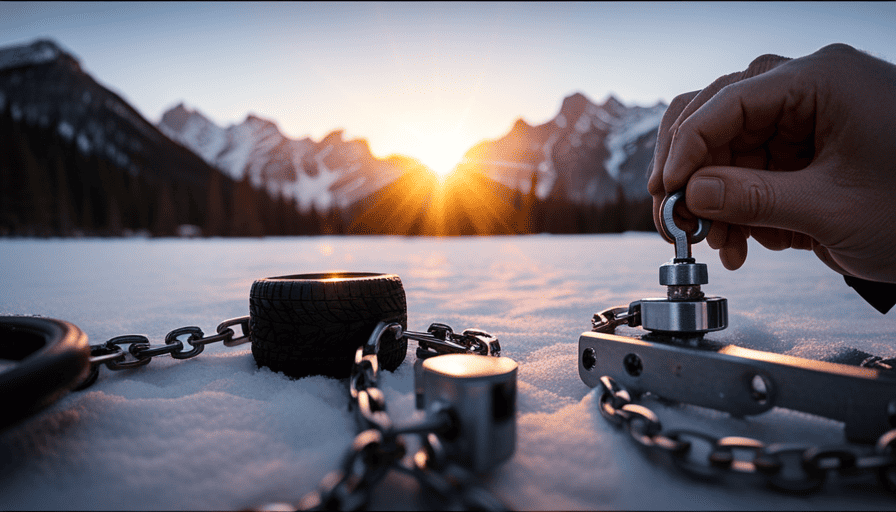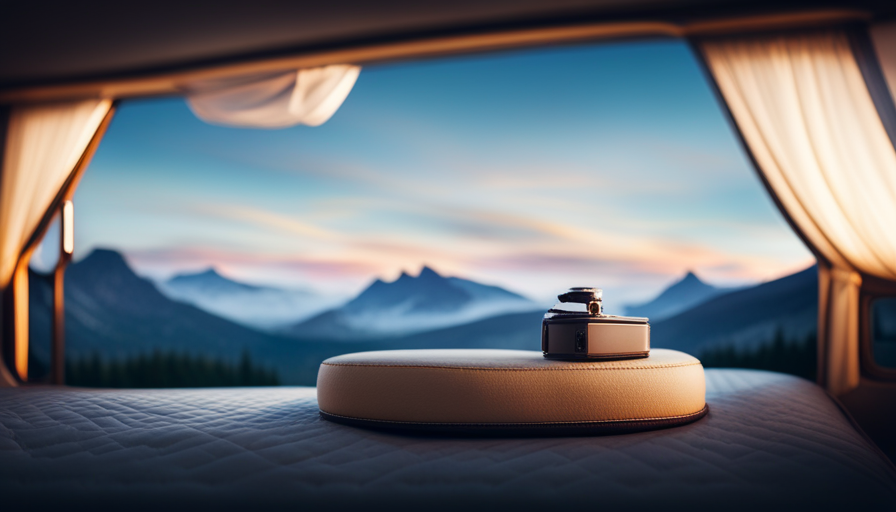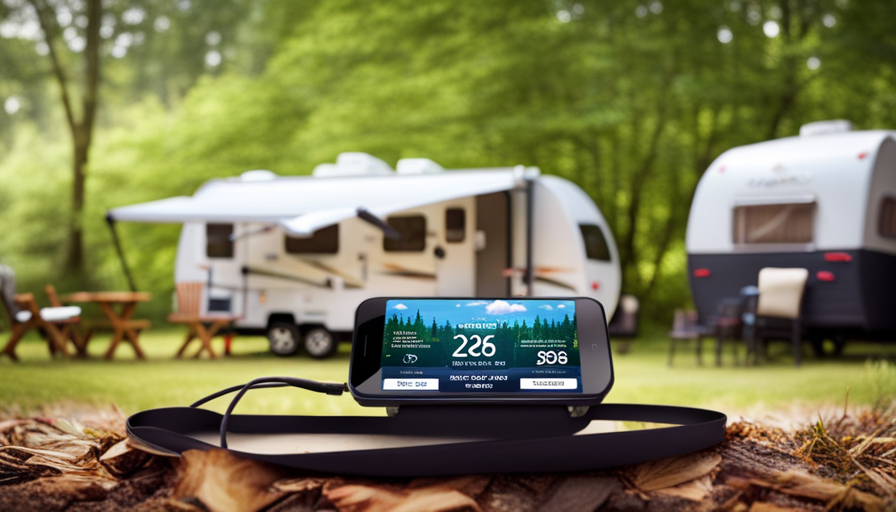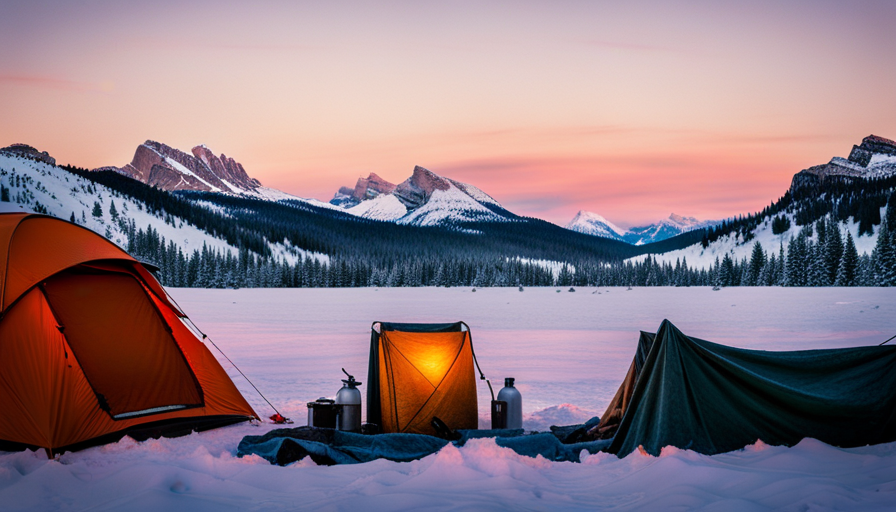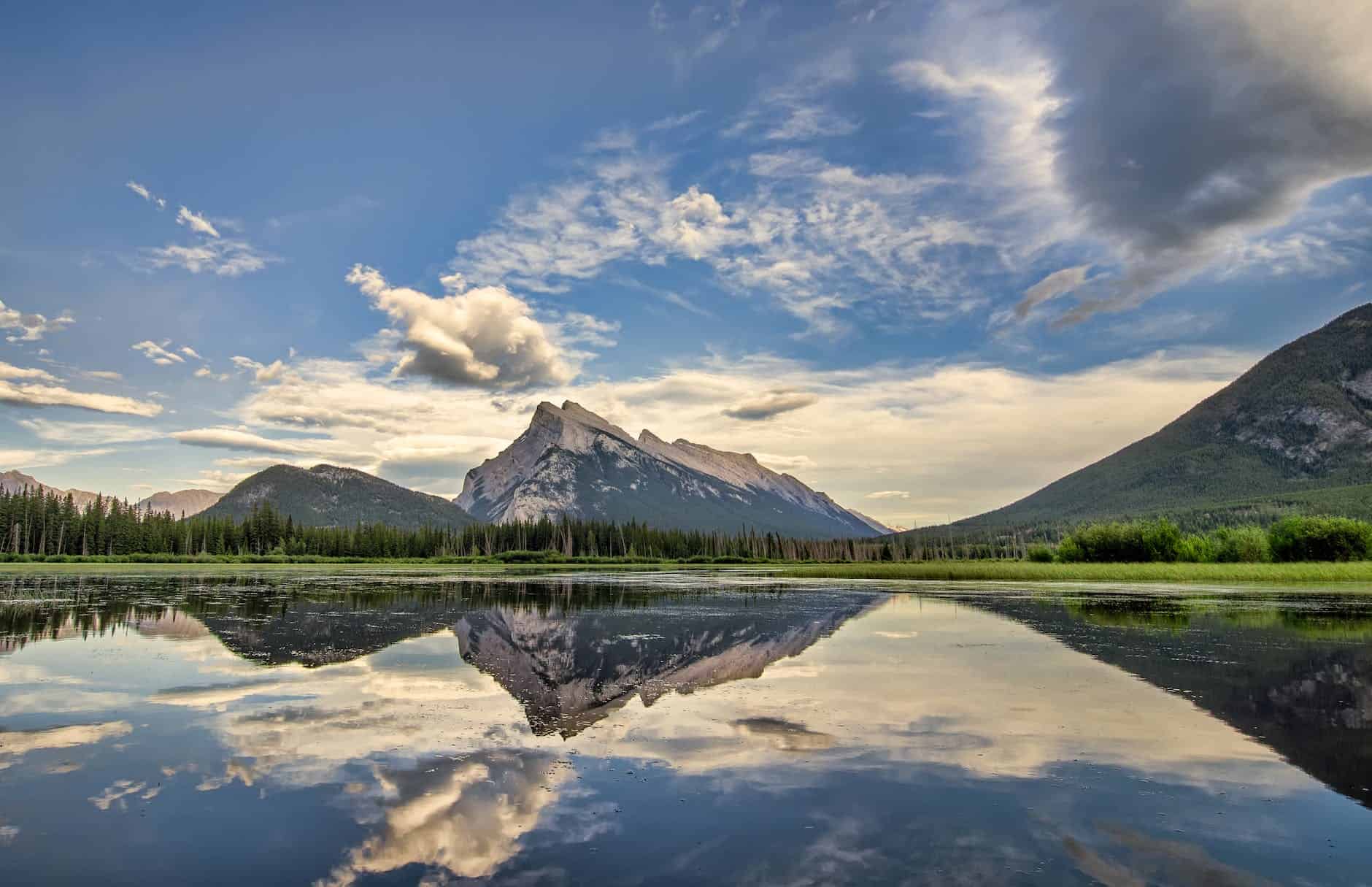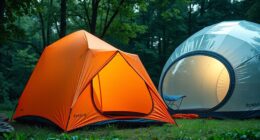Have you ever fantasized about embarking on an open road journey, in pursuit of adventure and making lasting memories? If so, I have the perfect solution for you – attaching a camper!
It’s the ultimate way to experience the great outdoors while still enjoying the comforts of home. But before you embark on this exciting journey, there are a few essential steps you need to follow.
In this article, I’ll guide you through the process of hooking up a camper with ease and confidence. From choosing the perfect campsite to setting up the interior and creating a comfortable outdoor space, I’ll share my knowledge, experience, and detailed instructions to ensure your camping adventure is a success.
So, grab your sense of adventure and let’s get started on this incredible journey of camper hooking!
Key Takeaways
- Choose a suitable campsite that meets your needs and preferences.
- Prepare the vehicle by ensuring it is in good working condition and has the necessary equipment for towing.
- Gather all necessary equipment such as leveling blocks, wheel chocks, and a hitch lock.
- Follow safety precautions when hooking up the camper, including properly attaching the hitch, connecting the electrical and brake systems, and checking for secure connections.
Choose the Right Campsite
Find the perfect campsite for your camper and get ready for an unforgettable adventure! Choosing the right campsite is crucial to ensuring a comfortable and enjoyable experience.
When researching campground amenities, look for facilities that align with your needs. Are you looking for full hookups, including water, electricity, and sewer connections? Or do you prefer a more rustic experience with just basic amenities? Knowing what you want will help you narrow down your options.
Additionally, consider the proximity of the campsite to attractions. Are there hiking trails, scenic views, or lakes nearby? Being close to these attractions can enhance your camping experience, allowing you to explore and enjoy nature’s beauty.
Once you’ve found the perfect campsite, it’s time to prepare your vehicle for the journey ahead. Transitioning into the next section, make sure your camper is equipped with all the necessary equipment and that it is properly maintained and in good working condition.
Prepare Your Vehicle
Make sure you’ve got everything ready on your vehicle before getting ready for your next adventure! Vehicle preparation is essential to ensure a safe and hassle-free camping trip.
Here are some key safety measures to take before hooking up your camper:
-
Check your tires: Inspect the tire pressure and tread depth to ensure they’re in good condition. Don’t forget to examine the spare tire as well.
-
Test the lights: Make sure all the lights on your vehicle and camper are working properly. This includes headlights, taillights, brake lights, and turn signals. It’s crucial for visibility and safety on the road.
-
Secure any loose items: Before hitting the road, secure any loose items both inside your vehicle and on the exterior. This prevents them from shifting or falling during transit.
Now that your vehicle is ready, it’s time to gather the necessary equipment for your camping adventure. Remember to bring essentials like leveling blocks, wheel chocks, and a hitch lock. These items will help ensure a smooth and secure hookup process.
Gather the Necessary Equipment
Equip yourself with all the necessary gear to embark on your camping adventure, ensuring you have everything you need for a smooth and secure journey. Before connecting your camper to your vehicle, it’s crucial to gather the essential camping gear.
First and foremost, you’ll need a sturdy towing hitch that matches your vehicle’s towing capacity. This’ll ensure a safe and reliable connection between your camper and your vehicle.
Additionally, gather some leveling blocks to stabilize your camper once it’s parked. These blocks’ll help you achieve a level surface, ensuring comfort during your camping experience. Don’t forget to bring wheel chocks to prevent your camper from rolling or shifting while parked.
Another essential piece of equipment is a trailer brake controller. This device allows you to control the brakes on your camper, providing additional safety when towing. Make sure to install it properly and test it before hitting the road.
Lastly, don’t forget to gather all the necessary safety equipment, such as fire extinguishers, first aid kits, and emergency roadside kits. These items’ll come in handy in case of any unforeseen circumstances.
Now that you’ve gathered all the essential camping gear, it’s time to connect the camper to your vehicle and start your adventure.
Connect the Camper to Your Vehicle
Once you’ve gathered all the necessary gear, it’s time to hitch your camper to your vehicle and get ready for an exciting journey. Connecting the camper to your vehicle may seem like a daunting task, but with the right knowledge and a few safety precautions, it can be done smoothly.
To connect the camper, you’ll need a hitch receiver on your vehicle. Ensure that the hitch receiver is the correct size for your camper’s tongue. Attach the hitch ball to the receiver and secure it tightly. Next, lower the camper’s tongue onto the hitch ball and lock it into place. Double-check that the latch is secure and the safety chains are properly attached to the vehicle. Finally, check the electrical connections to ensure the camper’s lights and brakes are functioning properly. Before hitting the road, it’s a good idea to also look into wifi options for camper, especially if you’ll be traveling to remote areas. Having a reliable internet connection can be crucial for staying connected and accessing important information while on the road. Research different providers and packages to find the best option for your camping needs.
To add depth to this process, here’s a helpful table:
| Step | Description |
|---|---|
| 1 | Attach the hitch ball to the receiver |
| 2 | Lower the camper’s tongue onto the hitch ball |
| 3 | Lock the tongue into place and secure the latch |
| 4 | Attach the safety chains to the vehicle |
| 5 | Double-check the hitch for proper connection and security |
Once the camper is connected, it’s important to take necessary safety precautions. Ensure that all lights are working properly, including brake lights and turn signals. Check the tire pressure on both the camper and the vehicle to ensure they are within the recommended range.
With the camper securely connected, you can now move on to the next step: leveling and stabilizing the camper.
Level and Stabilize the Camper
When you’ve got the camper hitched and ready to go, it’s time to ensure that the camper is level and stable, so you can hit the road with confidence and feel as steady as a rock.
Proper leveling techniques and stabilizing methods are essential for a comfortable and safe camping experience.
First, start by using a leveling tool, such as a bubble level or electronic leveling system, to check the levelness of your camper. Adjust the height of the camper by using leveling blocks or ramps under the tires. Gradually drive onto the blocks until the camper is level from side to side. Once leveled, engage the parking brake to keep the camper in place.
Next, stabilize the camper to minimize any movement while parked. Use stabilizer jacks or stabilizer bars to provide additional support and reduce sway. Place the jacks or bars at the corners of the camper and extend them until they firmly touch the ground. This will help prevent rocking and shifting when you move inside the camper.
With the camper now level and stable, you can move on to setting up electricity and water connections.
By ensuring the camper is properly leveled and stabilized, you’ll have a more enjoyable camping experience with peace of mind knowing that everything is secure and in place.
Set Up Electricity and Water
Now that you’ve got your camper leveled and stabilized, it’s time to get everything connected and ready for a comfortable stay.
One of the first things you’ll want to do is set up the electricity. Start by plugging in the power cord to the appropriate outlet on the campground pedestal. Make sure the circuit breaker inside the camper is turned off before plugging it in. Once it’s connected, you can turn on the breaker and test the outlets to ensure they’re working properly. It’s important to perform regular electricity maintenance while camping, such as checking for any frayed cords or loose connections.
Next, let’s talk about water. Most campsites offer water hookups, so you’ll need to connect your camper to the water source. Attach a hose to the campground water supply and then connect the other end to your camper’s water inlet. Turn on the water and check for any leaks. Remember, water conservation is crucial while camping, so be mindful of your usage and try to minimize waste.
Now that you’ve set up electricity and water, it’s time to move on to the interior of your camper.
Set Up the Interior
Get ready to transform the interior of your cozy camper into a haven of comfort and relaxation.
When it comes to organizing the interior, maximizing storage space is key. One tip is to utilize vertical space by installing shelves or hanging organizers on the walls. This will allow you to store items such as clothing, kitchenware, and toiletries without taking up valuable floor space.
Another useful trick is to invest in collapsible or multi-purpose furniture. For example, a folding table can be easily tucked away when not in use, and a sofa bed can serve as both seating and a comfortable sleeping area.
Additionally, consider using storage containers that fit perfectly under beds or benches to make the most of every inch of available space.
To maximize the functionality of your camper, make sure to keep items you frequently use within easy reach. Use hooks or magnetic strips to hang utensils or small tools on the walls, and install a hanging shoe organizer for easy access to shoes or small miscellaneous items.
Lastly, don’t forget to create a comfortable outdoor space where you can relax and enjoy the surrounding nature. Incorporate folding chairs, a small table, and a portable grill to make your outdoor area inviting and functional.
With these tips in mind, you’ll be able to organize the interior of your camper efficiently and create a comfortable outdoor space for all your adventures.
Create a Comfortable Outdoor Space
When setting up a camper, one of the key aspects to consider is creating a comfortable outdoor space. To achieve this, I highly recommend setting up an awning or canopy to provide shade and protection from the elements. This not only creates a cozy atmosphere, but also allows you to enjoy the outdoors even on hot or rainy days.
Additionally, arranging outdoor furniture such as chairs and tables can enhance the comfort and functionality of the space, providing a place to relax, eat, and socialize.
Lastly, creating a dedicated cooking and dining area can greatly improve your outdoor experience, allowing you to enjoy delicious meals amidst the beauty of nature.
Set up an awning or canopy
As you embark on the journey of hooking up your camper, imagine yourself as a skilled artisan, delicately crafting the perfect oasis by setting up an awning or canopy.
When it comes to awning installation tips, it’s important to select a sturdy and reliable model that suits your camper’s dimensions. Ensure that the awning is properly anchored and securely fastened to prevent any accidents during windy conditions.
Regular canopy maintenance and care is essential to prolong its lifespan. Clean the canopy regularly, removing any dirt or debris, and inspect it for any signs of wear or damage. Repair or replace any worn-out parts promptly to avoid further deterioration.
Now, with your awning or canopy in place, it’s time to arrange your outdoor furniture to create a cozy and inviting atmosphere.
Arrange outdoor furniture
Now that you’ve successfully set up your awning or canopy, it’s time to create a cozy and inviting atmosphere by arranging your outdoor furniture. Outdoor furniture arrangement tips are essential to make the most of your camping experience. Start by considering the layout of your camper and the space available outside. Place larger pieces, like a table or a sofa, in the center to anchor the arrangement. Then, create smaller seating areas using chairs or benches. Don’t forget to add some cushions and throws for added comfort. To emphasize a certain point or idea, here is a table that showcases creative ways to decorate your outdoor space:
| Idea 1 | Idea 2 | Idea 3 | Idea 4 | Idea 5 |
|---|---|---|---|---|
| Lighting | Plants | Rugs | Outdoor art | Hanging hammocks |
By incorporating these elements, you can transform your outdoor space into a relaxing oasis. Now, let’s move on to creating a cooking and dining area.
Create a cooking and dining area
To create a cozy and convenient outdoor dining experience, set up a cooking and dining area that allows you to enjoy delicious meals under the open sky. Here’s how:
- Choose a sturdy and spacious table that can accommodate all your guests.
- Set up comfortable chairs with cushions for a cozy ambiance.
- Hang string lights or lanterns to create a warm and inviting atmosphere.
- Use colorful tablecloths, placemats, and napkins to add a touch of style.
Planning meals efficiently is also crucial. Make sure to have all the necessary cooking utensils, pots, and pans easily accessible. Consider using a portable grill or a camping stove for cooking. Don’t forget to bring along your favorite spices and condiments to enhance the flavors of your dishes.
Now that your cooking and dining area is all set, it’s time to familiarize yourself with safety precautions to ensure a worry-free camping experience.
Familiarize Yourself with Safety Precautions
Make sure you’re fully prepared for a safe and enjoyable camping trip by familiarizing yourself with all the necessary safety precautions before hooking up your camper. Safety should always be a top priority when it comes to camping, so it’s important to have the right equipment and know what to do in case of emergencies.
First and foremost, make sure you have all the necessary safety equipment on hand. This includes items such as a fire extinguisher, smoke and carbon monoxide detectors, and a first aid kit. These items can help you handle any unexpected situations that may arise during your camping trip.
In addition to having the right equipment, it’s also crucial to know the emergency procedures. Familiarize yourself with how to safely exit your camper in case of a fire, and make sure everyone in your group knows the evacuation plan. It’s also a good idea to have a list of emergency phone numbers handy, including the nearest hospital and emergency services.
By taking the time to familiarize yourself with safety precautions and having the necessary equipment, you can ensure a safe and enjoyable camping adventure. Remember to always prioritize safety and be prepared for any situation that may come your way.
Now, let’s move on to the next section and learn how to fully enjoy your camping adventure!
Enjoy Your Camping Adventure!
When it comes to enjoying your camping adventure, there are three key points to keep in mind.
First, take the time to explore the great outdoors and immerse yourself in the beauty of nature. Whether it’s hiking through trails, swimming in lakes, or simply enjoying the fresh air, there’s always something to discover.
Second, engage in camp activities such as fishing, bird watching, or even stargazing. These activities not only provide entertainment but also allow you to connect with the environment in a meaningful way.
Finally, don’t forget to relax and unwind in nature. Take a moment to sit by the campfire, listen to the sounds of the wilderness, and let the stress of everyday life melt away.
Explore the outdoors
Ready to discover the wonders of the great outdoors and make unforgettable memories? Exploring the outdoors is one of the best parts of camping. When you hook up your camper and head out on the open road, you’ll have endless opportunities for outdoor activities and adventures.
Here are three items you should bring along to enhance your outdoor experience:
-
Hiking gear: Pack comfortable shoes, a backpack, and a map to embark on scenic trails and take in breathtaking views.
-
Water sports equipment: Don’t forget to bring your kayak, paddleboard, or fishing gear for a day of fun on the water.
-
Outdoor games: From frisbee to cornhole, having some games on hand will keep everyone entertained during downtime at the campsite.
With all the necessary camping gear loaded up, it’s time to engage in camp activities.
Engage in camp activities
Now that you’ve hit the open road and arrived at your campsite, it’s time to immerse yourself in a world of exciting camp activities. From campfire cooking to exploring hiking trails, there are endless opportunities to make the most of your outdoor adventure. Picture this: sitting around a crackling campfire, roasting marshmallows and sharing stories with fellow campers. It’s a scene straight out of a movie, but it can be your reality. And when you’re ready to stretch your legs, you’ll find a plethora of hiking trails waiting to be explored. Whether you prefer a leisurely stroll or a challenging trek, the options are endless. So pack your hiking boots and prepare to conquer nature’s wonders. As you engage in these exhilarating activities, you’ll soon find yourself ready to relax and unwind in the peaceful embrace of nature.
Relax and unwind in nature
Take a moment to let nature’s soothing embrace wash over you as you bask in the tranquility of the great outdoors. There’s something truly magical about being surrounded by nature, away from the hustle and bustle of everyday life.
Here are a few ways to relax and unwind while camping:
-
Campfire cooking: There’s nothing quite like the taste of food cooked over an open fire. Whether it’s roasting marshmallows for s’mores or grilling up a delicious meal, campfire cooking adds a special touch to any camping trip.
-
Wildlife spotting: Take the time to observe and appreciate the incredible wildlife that surrounds you. From birds soaring above to deer grazing in the distance, there’s always something amazing to see. Grab a pair of binoculars and explore the beauty of the natural world.
-
Stargazing: When the sun sets and the sky fills with stars, it’s the perfect time to lay back and gaze up at the night sky. Away from city lights, the stars shine brighter and the constellations seem to come alive. It’s a peaceful and awe-inspiring experience that will leave you feeling connected to the universe.
So, take a deep breath, relax, and let nature work its magic. Camping is the perfect opportunity to unwind and reconnect with the beauty of the natural world.
Frequently Asked Questions
How do I properly secure the camper to my vehicle to ensure it doesn’t detach while driving?
To properly secure the camper to my vehicle and prevent it from detaching while driving, I follow proper towing techniques.
Firstly, I ensure that the hitch and coupler are securely connected, double-checking for any loose bolts or pins.
Next, I attach safety chains crossed underneath the hitch, providing an additional layer of security.
Finally, I test the trailer brakes and lights to avoid any potential issues.
By following these steps, I avoid common mistakes and ensure a safe and worry-free journey.
What are the necessary steps for emptying and cleaning the camper’s waste tanks?
To properly empty and clean the camper’s waste tanks, start by wearing protective gloves and a mask.
First, locate the waste tank valves and open them, allowing the contents to drain into a designated disposal area.
Next, flush the tanks with clean water to remove any remaining waste.
Use a specialized tank cleaner and a long-handled brush to thoroughly clean the tanks.
Finally, close the valves and dispose of the waste properly.
How can I safely handle and store propane tanks while camping?
When it comes to storing and properly handling propane tanks while camping, there are a few key things to keep in mind. First, always ensure that the tanks are stored in a well-ventilated area, away from any ignition sources. It’s important to check for any leaks or damage before use, and never store the tanks near any flammable materials.
Additionally, it’s crucial to handle the tanks with care, avoiding any rough or abrupt movements that could cause damage. By following these guidelines, you can ensure a safe and enjoyable camping experience.
What should I do if I encounter a problem with the camper’s electrical system while on the road?
If I encounter a problem with the camper’s electrical system while on the road, there are a few troubleshooting tips I can follow.
Common electrical issues can include blown fuses, faulty wiring, or a dead battery. Firstly, I would check the fuses and replace any that are blown.
I would also inspect the wiring for any visible damage and repair or replace as necessary.
If the battery is dead, I would try jump-starting it or replacing it if needed.
Are there any specific regulations or guidelines regarding campsite etiquette that I should be aware of when setting up my camper?
When it comes to campsite regulations and camper setup tips, there are a few important things to keep in mind.
Firstly, always be respectful of your neighbors by keeping noise levels to a minimum and adhering to quiet hours.
Additionally, make sure to properly dispose of trash and leave the campsite as clean as you found it.
Lastly, be mindful of any specific rules or guidelines set by the campground regarding fires, pets, and vehicle parking.
Conclusion
Well, that’s it! You’ve successfully hooked up your camper and you’re ready for an unforgettable camping adventure. Remember, choosing the right campsite, preparing your vehicle, and gathering the necessary equipment are crucial steps in ensuring a smooth setup process.
Don’t forget to level and stabilize your camper, set up the interior to your liking, and create a cozy outdoor space. And of course, always prioritize safety.
So go ahead, hit the road, and enjoy the great outdoors like never before. Happy camping!

